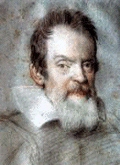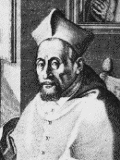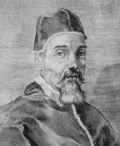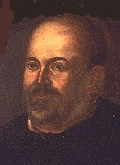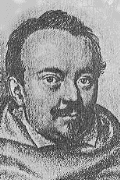Galileo Galilei
Cardinal Robert Bellarmine
Pope Urban VIII
Cardinal Francesco Barberini
Giovanni Ciampoli
Benedetto Castelli
Tommaso Caccini
Nicolaus Copernicus
Galileo Galilei was a great scientist--but much more than that. Had he been content to stick to his science--and limited his writing to dull treatises for other specialists--he would never have incurred the condemnation of the Catholic Church. Galileo had a mission: he wanted to increase awareness of scientific thought and, in the process, rescue the Catholic Church from its ostrich-like refusal to see the cosmos as it really was.
Galileo was born in Pisa in 1564--the same year Shakespeare was born and Michelangelo died. In the 1570s, Galileo and his family moved to Florence. In 1581, he entered the University of Pisa, as student of medicine and philosophy. At Pisa, Galileo undertook a study of the pendulum that would much later result in the development of the pendulum clock. In 1592, Galileo was appointed professor of mathematics at the University of Padua. In that position, Galileo pursued interests in the motion of falling bodies, spherical geometry, nautical engineering, and astronomy. During this period Galileo also came to accept the view of Copernicus, first developed in his treatise on the Revolutions of the Celestrial Orbs, that the Earth, rotating once a day on its own axis, revolved around the Sun.
In 1609, shortly before resigning his position at the University of Padua, Galileo produced the world's first working telescope based on a spyglass shown by a Dutch eyeglass maker. Galileo used his telescope for a series of remarkable astronomical discoveries, including the Milky Way, the moons of Jupiter, the phases of Venus, sunspots, and numerous lunar features. Drawing from these discoveries, Galileo proposed new arguments for the Copernican system--and presented these arguments in a series of letters.
As is described in detail elsewhere on this website, Galileo's eagerness to express Copernican views would earn him first, in 1616, an admonition from the Catholic Church and later, in 1633, a conviction for violating an injunction--supposedly issued seventeen years earlier--against holding, teaching, or defending Copernican views. Placed under house-arrest, Galileo would, in 1638, be allowed to move to his home near Florence. Though by then totally blind, he continued to teach and write. He died at his villa in Arcetri, just north of Florence, in 1642.
Cardinal Robert Bellarmine stood, at the time of Galileo's first published writing on the subject of Copernicanism, as the Church's chief guardian against deviationists and its chief defender of orthodoxy.
Seventy-four-years-old and in ill-health at the time of Galileo's 1616 admonition, Bellarmine was still a major force. In fact, it is not inaccurate to describe him as more in charge of events in 1615-16 than the dense and anti-intellectual Pope Paul V.
Bellarmine had waged many battles on behalf of papal power. He sought to create a papal superstate guided by the decisions of the Council of Trent. Bellarmine attacked anti-Catholic laws in England, angering English leaders--many of whom accused him of responsibility for the infamous "Gunpowder Plot" to blow up Parliament. In 1600, he framed the decision that brought Giordano Bruno, convicted heretic, to his death by fire at the stake.
Bellarmine's Scholastic inclinations made him naturally suspicious of Galileo's novel ideas about the universe. After giving an audience to Galileo in 1615, Bellarmine asked Jesuit astronomers for their opinion about Galileo's interpretation of discoveries made with his recently invented telescope. Bellarmine's fear of scandal and concern for preserving the intellectual status quo led him to conclude that discussing Copernicanism "absolutely" rather than "hypothetically" was "a very dangerous attitude." Bellarmine summoned Galileo to appear before him on February 25, 1616 and admonished him to abandon--and cease defending--Copernican views.
Prior to becoming the Church's chief theologian, Bellarmine grew up in a nobleman's family in Tuscany. He studied at Collegio Romano, Rome's Jesuit college. He served as a priest, taught theology, and worked as the spiritual director--and later as rector--for Collegio Romano.
Bellarmine took on few of the splendid trappings that usually accompanied life as a cardinal. He lived a prayerful and ascetic lifestyle. Although noted for his candor and temper, Bellarmine also could be easygoing and even childlike. One historian notes that he was famous for his "lighthearted punning."
Maffeo Barberini was born into a powerful family of Florentine merchants. He graduated from Collegio Romano, then earned a doctor of law degree from the University of Pisa. Barberini rose rapidly in the Church hierarchy. In 1606, he was appointed cardinal and, with the death of Pope Gregory XV in 1623, he was elected Pope, taking the name of Pope Urban VIII. As Pope, Urban VIII made it his goal to reinvigorate papal power.
In the early days of his reign, Galileo had reason to believe Maffeo Barberini's elevation to Pope might lead to a loosening of the Church's opposition to Copernican thought. Pope Urban VIII received Galileo for six long audiences. Although a humanist largely baffled by scientific principles, Urban VIII seemed genuinely interested in Galileo's ideas. Urban VIII assured Galileo that as long as he remained Pope, the memory of Copernicus had nothing to fear.
Eventually, however, the Pope's pride and suspicious would produce the dramatic confrontation with Galileo that culminated with his arrest, trial, and conviction in 1633. The troubles developed after Pope Urban VIII gave Galileo permission to write a book discussing the contending views of the universe: his Dialogue Concerning the Two Chief World Systems. Galileo's biggest mistake seems to have been putting into the mouth of an ignorant, literal-minded character named Simplicio the Pope's own views, offered to Galileo in 1623, concerning God's omnipotence. Urban VIII had argued that an all-powerful God could make the Sun and other heavenly bodies do as he pleased--notwithstanding the laws of physics. In his Dialogue, Galileo provided a response that must have made the Pope feel foolish: "Surely, God could have caused birds to fly with their bones made of solid gold, with their veins full of quicksilver, with their flesh heavier than lead, and with thier wings exceedingly small. He did not, and that ought to show something. It is only in order to shield your ignorance that you put the Lord at every turn to the refuge of a miracle."
Upset with what he saw as ridicule of his argument and convinced that the Dialogue was nothing but a thinly-veiled brief for the Copernican model, the Pope swung the machinery of the Church into motion against Galileo. The Pope insisted upon a formal sentence, a tough examination of Galileo, public abjuration, and "formal prison." In June 1633, the Pope got his wish.
Benedetto Castelli, a monk of Montecassino, ranked as Galileo's favorite disciple. The two often exchanged warm letters on matters ranging from scientific topics to the quality of wine and cheese. One letter from Galileo to Castelli in 1613, offering his views on matters theological and Copernican, became key evidence leading to his 1616 admonition. That same year, Castelli received an appointment as a professor of mathematics at the University of Pisa.
Castelli had a first-rate mind. He understood Galileo's thought as few men of the time did, and wrote his own treatise on The Motion of Water. He served as chief consultant on hydraulic projects beginning in 1626 and, later, as "Father Mathematician of His Holiness." In the latter capacity in 1633, Castelli tried to explain the meaning of Galileo's Dialogue to his Inquisitors.
Before Galileo arrived in Rome to stand trial, Castelli was sent to Brescia. He was allowed to return to Rome only after Galileo's departure.
Galileo had a trusted friend in Giovanni Ciampoli. A brilliant Latinist, Ciampoli adored the older scientist: "It seems impossible to me that one should frequent you and not love you....To hear you is to be convinced of the truth, and whatever I can do, I will always be at your service."
During Galileo's troubles of 1615-16, Ciampoli, under the allegiance of the Duke of Tuscany, corresponded regularly his hero, advising him of developments and intrigues within the Catholic Church hierarchy.
When Galileo reading the Dialogue for publication in 1630, Ciampoli concluded that the Pope's had only the warmest feelings for Galileo, writing from Rome to tell him: "You are awaited here more than any most beloved damsel." Of course, Galileo would soon discover otherwise, in part due to Ciampoli's unfortunate assurance to the Pope that Galileo faithfully followed all papal commands in the book. The Pope considered himself deceived by Ciampoli--previously thought an excellent candidate for cardinal-- and exiled him to the village of Montalto della Marca, where he served as governor.
Ciampoli accepted his situation gracefully. In 1633, he wrote to Galileo: "Come to see me, my persecuted Socrates, we shall take good care of your health here....As for myself, I have found my consolation in study, and I still hope to write something whereby I will be remembered."
Ciampoli died in Iesi in 1643.
Cardinal Francesco Barberini (1597-1679)
Cardinal Francesco Barberini, the nephew of Pope Urban VIII, was one of ten judges in Galileo's trial. Barberini led a faction of cardinals that sought lenient treatment for Galileo. He persuaded Commissary-General Firenzuola to visit Galileo in March, 1633 and discuss with him a compromise solution to the compromise. Under the arrangement preferred by Barberini, Galileo would admit that the Dialogue went too far and violated papal instructions and, in return, the book could be distributed (with revisions) and Galileo spared imprisonment. Galileo agreed to the deal, but a majority of the ten cardinals rejected Barberini's plan. Barberini was one of three judges who did not sign Galileo's sentence, which banned the Dialogue and ordered Galileo's imprisonment.
After Galileo's sentencing and abjuration, Barberini succeeded in altering a plan to send Galileo to a monastery for a period of prolonged penitence, and arranged instead for him to be transferred to the custody of the Archbishop of Sienna.
Father Tommaso Caccini, a Dominican monk and inveterate scandal-maker, was the chief instigator of Galileo's troubles. On December 20, 1614, Caccini preached a sermon in Florence that condemned mathematics and alleged that Copernicanism was either heretical or very close to it. Caccini, a "turbulent ignoramus," contended that Copernicus' Sun-centered system contradicted Scripture's description of an Earth-centered system.
In March of 1615, Caccini traveled to Rome and denounced Galileo before the Holy Office. In his deposition, Caccini claimed that Florence was full of "Galileists" who denied miracles, claimed God was an accident, and espoused Copernican views. Caccini's move was part of a plot calculated to force Rome to act against Galileo.
Galileo accuratedly sized up his enemy, describing Caccini as a person "of very great ignorance, no less a mind full of venom and devoid of charity." Caccini's own brother shared this appraisal, calling his sibling "a dreadful fool" whose "ugly drives" and "performance...makes no sense in heaven or earth."
After playing his role in gaining Galileo's admonition in 1616, Caccini managed to earn the enmity of powerful Cardinal Borghese and was forced to leave Rome. He spent his later years as Prior of San Marco in Florence.
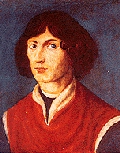
Nicolaus Copernicus is credited with first proposing an alternative to the reigning Ptolemaic explanation of the universe. Rather than a system in which the Sun and stars revolved around the Earth once a day, as Ptolemy proposed, Copernicus suggested a Sun-centered system in which the Earth, rotating on its own axis every twenty-four hours, revolved around the Sun once a year. Copernicus published his views in a 1543 treatise, the Revolutions of the Celestial Orbs. Copernicus dedicated the book to Pope Paul III. The book did not offend Catholic censors (at least until 1616, when it was placed on the Index of banned books), in large part owing to a preface which (without much conviction) denied any pretension of the physical validity of the model discussed. Initially, the book met mostly with skepticism. Later, of course, the Copernican system would be championed by others, including the German mathematician Johannes Kepler and, most famously, Galileo in many letters and in the book that led to his trial, Dialogue Concerning the Two Chief World Systems.
Copernicus was born into a Polish middle-class family. He studied at the Universities in Krakow, Bologna, Padua, and Ferrara, developing strong backgrounds in mathematics, medicine, and canon law. Copernicus spent most of his life leading a sheltered academic life as a canon in the cathedral of Frauenburg.
Goethe wrote of Copernicus' great insight:
"Of all human discoveries and opinions, none may have exerted a greater effect on the human spirit than the doctrine of Copernicus. The world had scarcely become known as round and complete when it was asked to waive the tremendous privilege of being the center of the universe. Never, perhaps, was a greater demand placed on mankind--for by this admission, so many things vanished in mist and smoke!'

